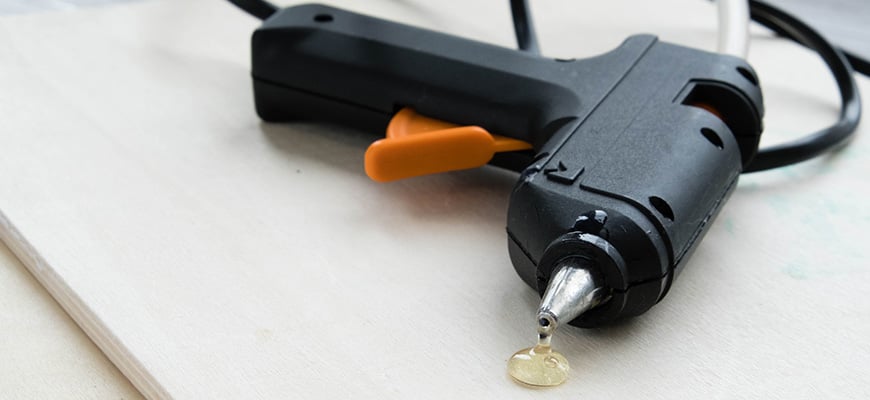
Creating your own Rocket Industrial personal account has many benefits:

Hot melt adhesive, or hot melt glue, is used in a variety of bonding applications in various industries. In this blog, we will provide an introductory overview of these versatile adhesives, exploring their applications, uses, and benefits.
Hot melt adhesives are made from 100% thermoplastics which offers a quick, clean and economical way to bond a variety of materials. When heated at various temperatures they become liquid and can be sprayed, roll coated or applied as a bead form. Hot melt adhesives are manufactured in glue sticks, slats, beads, chips, pellets, pillows and blocks.
Hot melt glues are used in manufacturing across a wide variety of markets and applications:
Hot melt can be used on various types of materials:
Why are hot melt adhesives used instead of solvent-based or water-based adhesives? Here are some of the key advantages:
EVA Hot Melt Glues – EVA stands for ethylene vinyl acetate. The most common hot melt adhesive used in packaging and paper converting processes. Extremely versatile with a range of temperature resistance. It sets quickly and is waterproof.
Polyethylene Hot Melt Glues – Low odor and provide excellent thermal stability. It also works well for case, carton, and tray sealing applications.
Polyurethane Hot Melt Glues (PUR) – Cools and forms a bond like a traditional hot melt but provides exceptional heat and cold resistance upon exposure to air moisture. Can’t be re-melted.
Metallocene – A metal-catalyzed polyethylene adhesive. It offers more thermal stability than other hot melts. Light-colored and low odor.
Polyamide Hot Melt Glues – Heat resistant and provides a high-strength bond. It also offers excellent resistance to grease and oils. For use on difficult-to-bond materials.
APAO Hot Melt Glues – Stands for amorphous poly alpha olefins. Soft, tacky and flexible. Often used in product assembly applications.
Removable Low Tack to High Tack Glue – Commonly used on non-porous surfaces to create a removable bond without leaving a messy residue.
Pressure Sensitive Adhesives (PSA) – Also known as self-stick adhesive, it forms a bond when pressure is applied to bond the adhesive with the adherend. No solvent, water, or heat is needed to activate the adhesive.
What temperature does hot melt glue melt at?
Hot glue should not be used on materials where the high temperature could damage the product or material. It should also be used with caution to avoid burns. Carefully selecting the right type of glue gun for your application is essential. Low-temperature guns melt glue at 250 degrees and can be used on more delicate materials. High-temperature hot glue sticks and guns can reach 400 degrees and should only be used on durable, hard materials. Dual-temperature hot melt tool options are also available.
Are there different glues for use on different materials?
Yes, glues are designed to work on certain substrates so it's important to use the correct glue for your application. You will want to use a different glue for general packing applications vs more difficult substrates such as laminated board. We can assist with finding a glue product that will bond the best with your material.
Are there different glues for cold environments vs hot environments?
Yes, some types of hot melt hold up better in extreme environments. Environmental temperature affects the adhesive viscosity and set speed of glue, so make sure to check products' specifications if you will be sealing and storing in these types of environments.
Here are the most commonly used terms when talking about hot melt adhesives:
Adhesive – A substance for bonding, affixing, or holding material together.
Ambient Temperature – The temperature surrounding the object to be glued.
Bond – The attachment of an adhesive to a surface.
Compression Time – The required amount of time to hold the bond while the hot melt cools. This step is key to achieving a good, strong bond
Curing – The chemical process that takes place when a material hardens. Different glues have different curing processes that can be instant to requiring contact with moisture.
Degradation – Damage to the appearance of hot melt due to a change in the chemical structure.
Glue Backup – This occurs when an operator tries to use a glue gun before it reaches the correct temperature. This causes the glue to be forced back along the barrel of the applicator.
Melt-Back – This happens when a glue gun has been left on for too long without use causing the glue to over-soften and be forced back along the barrel of the applicator.
Open Time – The elapsed time between application and compressing.
Tack – The stickiness of an adhesive to adhere to a material.
Setting Temperature – The optimal temperature for the adhesive to set.
Thermoplastic – A material that is capable of being liquified and re-solidified.
Viscosity – A measure of the ability of a liquid to resist flow. Should be consistent in each batch.
Rocket Industrial offers a full line of adhesives and glue systems for packaging and product assembly applications. Contact us for recommendations and samples to meet your specific hot melt application requirements.